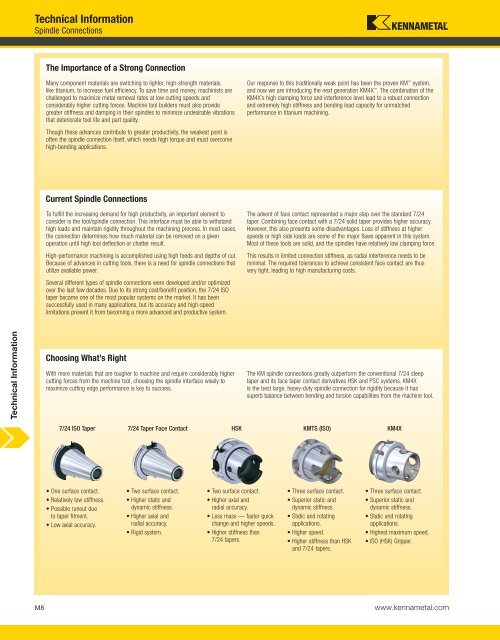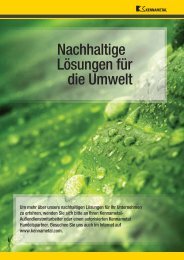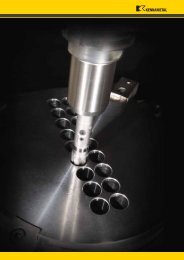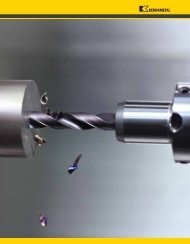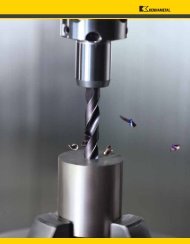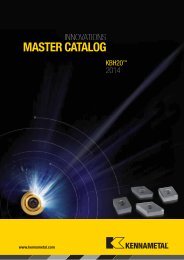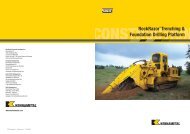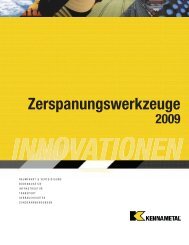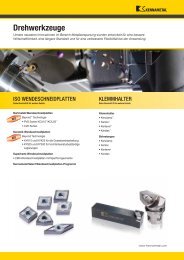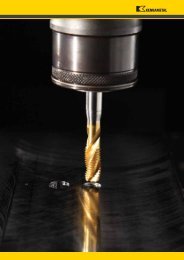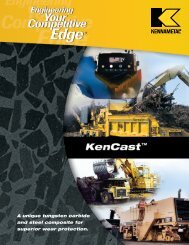You also want an ePaper? Increase the reach of your titles
YUMPU automatically turns print PDFs into web optimized ePapers that Google loves.
<strong>Technical</strong> <strong>Information</strong><br />
<strong>Technical</strong> <strong>Information</strong><br />
Spindle Connections<br />
The Importance of a Strong Connection<br />
Many component materials are switching to lighter, high-strength materials,<br />
like titanium, to increase fuel efficiency. To save time and money, machinists are<br />
challenged to maximize metal removal rates at low cutting speeds and<br />
considerably higher cutting forces. Machine tool builders must also provide<br />
greater stiffness and damping in their spindles to minimize undesirable vibrations<br />
that deteriorate tool life and part quality.<br />
Though these advances contribute to greater productivity, the weakest point is<br />
often the spindle connection itself, which needs high torque and must overcome<br />
high-bending applications.<br />
Current Spindle Connections<br />
To fulfill the increasing demand for high productivity, an important element to<br />
consider is the tool/spindle connection. This interface must be able to withstand<br />
high loads and maintain rigidity throughout the machining process. In most cases,<br />
the connection determines how much material can be removed on a given<br />
operation until high tool deflection or chatter result.<br />
High-performance machining is accomplished using high feeds and depths of cut.<br />
Because of advances in cutting tools, there is a need for spindle connections that<br />
utilize available power.<br />
Several different types of spindle connections were developed and/or optimized<br />
over the last few decades. Due to its strong cost/benefit position, the 7/24 ISO<br />
taper became one of the most popular systems on the market. It has been<br />
successfully used in many applications, but its accuracy and high-speed<br />
limitations prevent it from becoming a more advanced and productive system.<br />
Choosing What’s Right<br />
With more materials that are tougher to machine and require considerably higher<br />
cutting forces from the machine tool, choosing the spindle interface wisely to<br />
maximize cutting edge performance is key to success.<br />
• One surface contact.<br />
• Relatively low stiffness.<br />
• Possible runout due<br />
to taper fitment.<br />
• Low axial accuracy.<br />
• Two surface contact.<br />
• Higher static and<br />
dynamic stiffness.<br />
• Higher axial and<br />
radial accuracy.<br />
• Rigid system.<br />
• Two surface contact.<br />
• Higher axial and<br />
radial accuracy.<br />
• Less mass — faster quick<br />
change and higher speeds.<br />
• Higher stiffness than<br />
7/24 tapers.<br />
Our response to this traditionally weak point has been the proven KM system,<br />
and now we are introducing the next generation KM4X . The combination of the<br />
KM4X’s high clamping force and interference level lead to a robust connection<br />
and extremely high stiffness and bending load capacity for unmatched<br />
performance in titanium machining.<br />
The advent of face contact represented a major step over the standard 7/24<br />
taper. Combining face contact with a 7/24 solid taper provides higher accuracy.<br />
However, this also presents some disadvantages. Loss of stiffness at higher<br />
speeds or high side loads are some of the major flaws apparent in this system.<br />
Most of these tools are solid, and the spindles have relatively low clamping force.<br />
This results in limited connection stiffness, as radial interference needs to be<br />
minimal. The required tolerances to achieve consistent face contact are thus<br />
very tight, leading to high manufacturing costs.<br />
The KM spindle connections greatly outperform the conventional 7/24 steep<br />
taper and its face taper contact derivatives HSK and PSC systems. KM4X<br />
is the best large, heavy-duty spindle connection for rigidity because it has<br />
superb balance between bending and torsion capabilities from the machine tool.<br />
7/24 ISO Taper 7/24 Taper Face Contact HSK KMTS (ISO) KM4X<br />
• Three surface contact.<br />
• Superior static and<br />
dynamic stiffness.<br />
• Static and rotating<br />
applications.<br />
• Higher speed.<br />
• Higher stiffness than HSK<br />
and 7/24 tapers.<br />
• Three surface contact.<br />
• Superior static and<br />
dynamic stiffness.<br />
• Static and rotating<br />
applications.<br />
• Highest maximum speed.<br />
• ISO (HSK) Gripper.<br />
M8 www.kennametal.com


